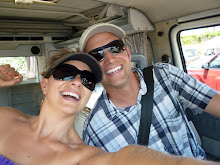Yesterday, Tyson and I went diving off the northwest coast of Phu Quoc Island, Vietnam. We knew that the diving was not going to be as spectacular as it was in Ko Tao or the Similian Islands in Thailand but we were excited nonetheless; it's hard to not be excited about diving in 85 degree water. What we saw when we sunk beneath the surface of the waves was dramatic and depressing. Although there were some corals in varying states of health, there were hardly any fish. And the fish that we did see were very small. The hundreds of fishing boats that we had seen lining the harbor and coastline (and lighting up the horizon like a baseball game at night) have clearly taken their toll on the marine ecosystems here on Phu Quoc.
We had our suspicions that overfishing here was a problem. The twenty-odd food stalls at the night market all proudly displayed an array of fresh fish, squid, shrimp, scallops, clams, cockles, and crabs. EVERY NIGHT. And every night, the market was full of tourists (mostly Vietnamese but some Westerners) who just couldn't wait to get their chopsticks around these delights from the sea. This level of harvest, this rate of extraction - it just can't be sustainable. And the impacts of this fishing were blatantly obvious as we drifted through the ocean, breathing our compressed air, and wondering where all the fish were.
Concern about the state of our fisheries, locally and globally, does not seem to be at the forefront of the general public. We all hear that eating fish is good for us (we need those Omega-3 fatty acids) but we don't really think about where that fish is coming from or how the way it has been fished might have a broader impact on the ocean as a whole. Educating yourself about where your seafood is coming from and whether it is fished sustainably is huge step in helping make sure that Tyson and I (and everyone else) always have lots of fish to see when we go diving.
If you want more information about how to buy sustainable seafood, please check out Monterey Bay Aquarium's Seafood Watch website.
PS - I must note that the diving at Ko Tao and Similan Islands was so stunning because the waters are fully protected marine reserves where no fishing is allowed. Support the creation of marine protected areas; they work!
Monday, March 15, 2010
Subscribe to:
Post Comments (Atom)

No comments:
Post a Comment